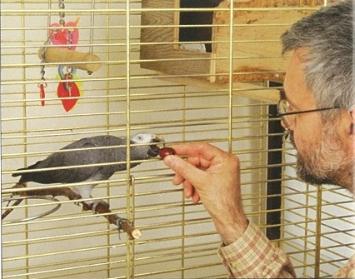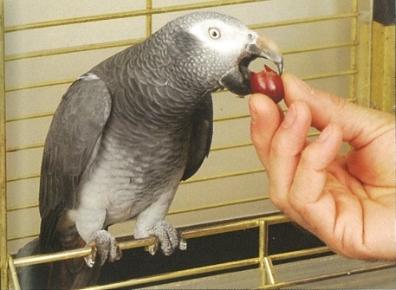Grey parrots vary greatly in their degree of tameness and confidence. While most tend to be relatively nervous or shy, others can be very bold, even quite extrovert. Nervous greys require special care before and during training. Often, such nervousness is due to the way other people have handled the bird in the past and greys have very long memories. Some greys will be wild-caught birds which have been trapped and imported as 'pet' birds. Wing-clipping also causes nervousness and these birds may be extremely wary of people, particularly their hands. This nervousness may be made worse by the bird being 'trapped' in a cage and so unable to escape fearful things happening near it.
Before attempting to ask a nervous bird to step up onto the hand, you will need to go through a gentle taming process which may take several weeks. The same principles of rewarding desired behaviours are used as in the more formal training sessions, but progress with nervous birds may be slow. These birds should always have a perch in their cage which is high enough to allow them to be above your eye-level when you are standing by the cage. This will reduce the bird's fear of people who come close.
Before attempting to ask a nervous bird to step up onto the hand, you will need to go through a gentle taming process which may take several weeks. The same principles of rewarding desired behaviours are used as in the more formal training sessions, but progress with nervous birds may be slow. These birds should always have a perch in their cage which is high enough to allow them to be above your eye-level when you are standing by the cage. This will reduce the bird's fear of people who come close.
A careful, gentle approach for nervous birds
Start the taming process by sitting down below the bird while it is in its cage but not so close that it shows any signs of nervousness. Sit side-on to the bird and avoid looking directly at it. Let the bird see you doing something such as reading, or having a snack to eat Keep these sessions quite short at first, just two or three minutes long, and extend them as the bird gets used to you. Gradually sit closer to the bird so long as this does not make him nervous. After a few sessions the bird's confidence should improve and he may become interested in any food you may be eating. At this point, offer the bird a favourite titbit through the bars of the cage. At later sessions, try opening the cage door and offer a food treat directly to the bird while he is still in the cage. Just place your hand-held titbit below his beak, provided he appears likely to accept this. Later, try leaving the cage door open and offer a treat after the bird has come out or just moved towards the open cage door. To get him to return, place a treat in his food bowl to tempt him back in. Always proceed at a pace which is comfortable for the bird. Use softly spoken words of encouragement as you make progress in this taming stage.
Step 1: Eating your own food in front of a
nervous bird can help to keep him calm.
nervous bird can help to keep him calm.

Step 2: Later, if the bird seems interested your food,
offer him a titbit through the cafe bars.
offer him a titbit through the cafe bars.

Step 3: Next, encourage the bird to come to the
open cage door, and then reward him with a treat.
open cage door, and then reward him with a treat.

Step 4: If he leaves the cage, encourage his
return by conspicuously placing a treat in his bowl.
return by conspicuously placing a treat in his bowl.

This bird appears nervous but inquisitive at the same time.
Note the alert eye and how the head is stretched forward as he concentrates on something that has caught his attention. He has been badly wing-clipped which may contribute to his anxious demeanour. Wing-clipped birds can feel trapped as they cannot
fly from danger.
Note the alert eye and how the head is stretched forward as he concentrates on something that has caught his attention. He has been badly wing-clipped which may contribute to his anxious demeanour. Wing-clipped birds can feel trapped as they cannot
fly from danger.